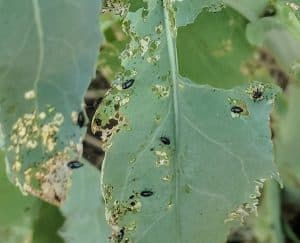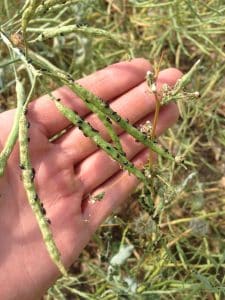The yield risk from flea beetle feeding late in the season is low in most situations. Numbers have to be very high – perhaps 100 per plant – before economic losses occur. Manitoba Agriculture’s provincial entomologist John Gavloski shares the following:
“Late-season flea beetles can commonly be seen on canola, and will do some feeding. Generally this is not going to be economical to control, although there can be exceptions.
“Regarding flea beetles in canola late in the summer, a study was done at Agriculture and Agri-Food Canada in Saskatoon to determine how economical they are. The study concluded that: Flea beetle feeding on canola in late-summer is rarely an economic concern. Flea beetle feeding that occurs when seeds in lower pods of canola are at the green stage or beyond is unlikely to affect seed yields regardless of the infestation rate of flea beetles. Even when seeds are translucent to green, numbers higher than 100 flea beetles per plant, and for some cultivars higher than 350 per plant, may be necessary to cause significant yield reductions (Soroka and Grenkow. Can. J. Plant Sci. 2012: 97-107).
“Canola can withstand high levels of flea beetles late in the season, so a bit of feeding on pods is tolerable. But we have seen situations where there was a lot of damage occurring on pods. It is good to keep an eye on how much feeding is occurring to pods, and if it is severe there may be instances where control is needed. Sometimes the flea beetles are doing more damage along a particular edge or part of the field.
“Once the canola becomes less palatable for the flea beetles or is being cut, these species of flea beetles will be on the move looking for other cruciferous host plants to feed on, including cruciferous garden vegetables and flowers, and can be hard to manage.”
See more on the flea beetle lifecycle in the Canola Encyclopedia.


Common questions
Here are two frequently asked questions, with responses provided by AAFC’s Julie Soroka:
1. If late-season flea beetles are 100% crucifer species, does that mean they’ll be mostly crucifer next year?
Not likely. Several researchers have found that P. striolata (striped flea beetles) numbers are usually higher in the spring than in the fall, while the reverse is more often the case for P. cruciferae — the most common all-black species. AAFC Saskatoon entomologist Julie Soroka says she is seeing higher numbers of P. striolata in the fall than she used to, she says P. cruciferae is still usually the dominant fall species.
2. If these late season flea beetles overwinter as adults and start feeding on canola seedlings next spring, would it be worthwhile to spray them now to reduce the spring population?
High fall numbers and suitable spring weather conditions are critical factors in determining how big a problem flea beetles will be next year. Fall spraying of flea beetles might reduce flea beetle numbers in a locality, but could also kill many beneficial insects. And migration from surrounding areas next spring could negate the flea beetle reduction this fall, while making matters worse by decreasing the impact of beneficial insects next spring. Plus the seed treatment you’ll be using next spring might be enough protection.